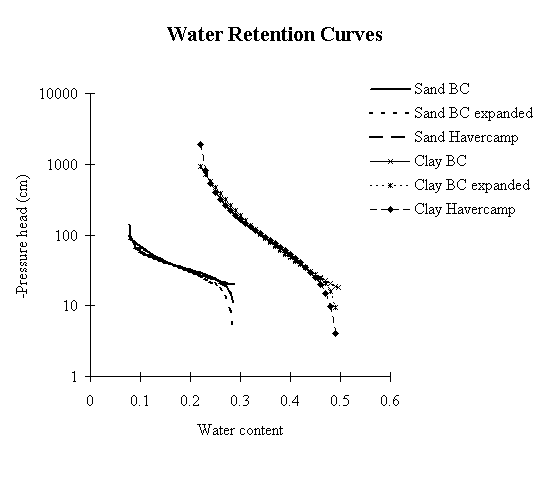Richards Equation:Distributed parameters
As with all distributed parameters, the distributed parameters for the Richards’ equation are assigned using index maps and the mapping tables as described in Chapter 5. Assignment of parameters with Richards’ equations differs from the other processes in that for each different soil type in the index map, three soil layers must be defined. Parameters and discretization must also be assigned for all three layers. The parameters that must be defined depends on which option is used to define the PCS curves, Brooks or Havercamp. The Havercamp formulation is best if laboratory data are available to fit the needed parameters as detailed below (Figure 22). Testing by Downer (2002) showed that the Havercamp equations could best define the soil behavior. If no detailed data exist, as is typical, then the Brooks and Corey (1964) method may be used and the parameters needed for the Brooks and Corey model can either be measured or estimated from soil textures and literature sources such as Rawls, Brakensiek, and Saxton (1982).
Parameters for the Richards’ equation are assigned in the GSSHA Mapping Table Editor. For the Brooks and Corey method, the following parameters are assigned for each of the three layers.
- Hydraulic Conductivity –saturated hydraulic conductivity of the soil describes the rate water will enter the soil under unit head and saturated conditions (cm/hr) .
- Porosity - volume of voids/total volume of soil, fraction between 0.0 to 1.0 (m3/m3).
- Residual saturation –water content of air dry soil, fraction between 0.0 to 1.0 (m3/m3).
- Wilting point – fraction between residual saturation and porosity, water content below which plants cannot uptake water from the soil (m3/m3).
- Depth – thickness of the soil layer (cm). Should be rounded up or down to nearest centimeter.
- Lambda – pore distribution index (cm/cm). Describes the straight line length to the soil water path length.
- Bubbling pressure – pressure at which air enters the soil column (cm). Must be negative.
- Delta Z – vertical cell size of the layer (cm). Should be evenly divisible into the depth of the layer.
For the Havercamp method, the following parameters must be specified for each of the three layers. Parameters from the Havercamp method must be determined from field or laboratory testing.
- Hydraulic Conductivity –saturated hydraulic conductivity of the soil (cm/hr) describes the rate water will enter the soil under unit head and saturated conditions.
- Porosity - volume of voids/total volume of soil, fraction between 0.0 to 1.0 (m3/m3).
- Residual saturation –water content of air dry soil, fraction between 0.0 to 1.0 (m3/m3).
- Wilting point – fraction between residual saturation and porosity, water content below which plants cannot uptake water from the soil (m3/m3).
- Depth – thickness of the soil layer (cm). Should be rounded up or down to nearest centimeter.
- Alpha – factor fitted from field or laboratory data.
- Beta – factor fitted from field for laboratory data.
- AHAV – factor fitted from field for laboratory data.
- BHAV - factor fitted from field for laboratory data.
- Delta Z – vertical cell size of the layer (cm). Should be evenly divisible into the depth of the layer.
Related Topics
GSSHA Wiki Main Page
Primer Main Page
- Richards' Equation
- Global parameters
- Distributed parameters
- Soil depth and discretization
